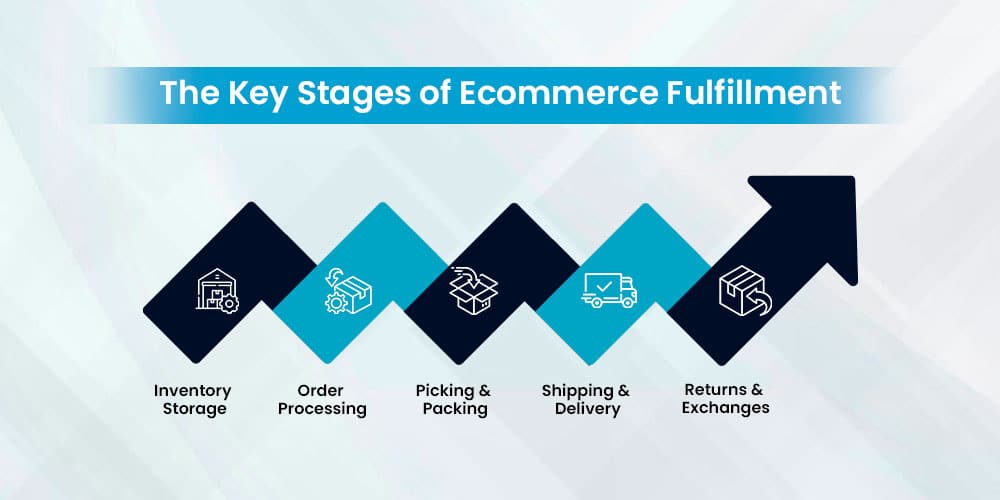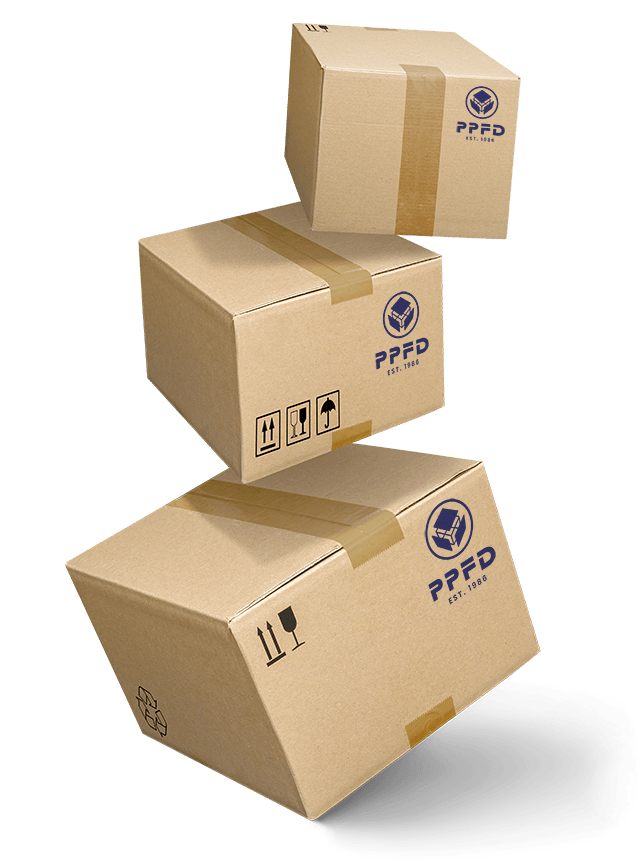
No one out here is just expecting to sell online; they are looking forward to delivering the best experiences. That means it’s not enough to have a great product or a beautifully designed store. If your order doesn’t arrive on time, in perfect condition, and with a return process that doesn’t make your customer happy, you’ve already lost the game.
That’s where ecommerce fulfillment comes in, not just as a backend task but as a core business function. It connects everything: your marketing promise, your customer expectations, and your brand reputation.
This guide breaks down everything you need to know about ecommerce fulfillment, from how it works to when to outsource, what options are available, and the common myths holding sellers back.
So, if you’re running an ecommerce brand or planning to launch one, this is for you.
At its core, ecommerce fulfillment is the process of delivering online orders to your customers. It encompasses all the steps that occur after a sale is made, including storing products, picking and packing, shipping, tracking, and handling returns or exchanges.
While it may sound like simple logistics, it’s anything but. It’s the invisible engine that powers customer satisfaction, reviews, repeat purchases, and ultimately, your bottom line.
If you want to go even deeper into how storage and warehousing fit into this process, read this: What is Ecommerce Warehousing? A Step-by-Step Breakdown.

Before any shipment, your inventory needs a place to be stored. This could either be a simple garage or a dedicated warehouse. Not mandatory to spend in dedicated storage, but if one, you can have your products organized, which helps a lot for a fast move when you receive an order. Reliable warehousing and distribution ensures your inventory stays organized, safe, and ready for dispatch.
As soon as a customer places an order, your system jumps into action. It confirms the purchase, locates the right item in your inventory, and sends it for picking and packing. Accuracy at this stage ensures fewer errors and happier customers.
During the packing process, a team or maybe a system picks the right product, checks it for quality, and then packs it securely. If you’re branding your packaging, this is where the “unboxing experience” starts. This includes bubble wrap, sturdy boxes, thank-you notes, freebies, or whatever adds that personal touch. Many businesses rely on external teams for this, if you’re scaling, pick and pack fulfillment can make all the difference.
As and when the order is packed, it is handed over to the delivery partner. This is where real-time tracking starts, and reliable delivery timeliness matters. No matter if it’s same-day delivery or a standard one, this one step is going to decide your customer’s experience and satisfaction. If speed is your priority, consider crossdocking to reduce storage time and get products out faster.
Look, you have to understand that not every order is going to be perfect. But you can regain that trust with your return process. Whatever the reason is for the return or exchange, it is your responsibility to ensure a hassle-free return process. And trust us, this is what is going to convert your unhappy buyer into a returning customer.

There is not only one dedicated way to handle fulfillment, rather it depends entirely on where –
Here are the three primary models, each suited to different business stages and goals:
In this setup, you handle everything on your own — storing, packing, shipping, and returns. This works well for early-stage businesses with limited product lines and manageable order volumes.
Pros:
Cons:
Example: A small artisanal soap brand may ship 10-15 orders per week from a home studio. During Diwali or Black Friday, that number can triple, and quickly become unsustainable.
Here, you outsource your fulfillment operations to a logistics partner. They handle inventory storage, order picking, packing, shipping, and even returns if needed. You focus on sales and marketing — they take care of the backend.
Pros:
Cons:
Example: A DTC skincare brand outsources to a 3PL like Shiprocket or Red Stag Fulfillment. Their orders go out faster, returns are processed automatically, and they can focus on launching new products instead of packing boxes.
Dropshipping is the most hands-off model; you don’t store or ship the products yourself. Instead, you forward orders to a supplier, who ships directly to the customer.
Pros:
Cons:
Example: A new seller runs a niche T-shirt store. Instead of holding stock, they use a dropshipping supplier who prints and ships each T-shirt on demand.
Ecommerce is more than just moving products; it’s about doing things quickly, accurately, and consistently. Unfortunately, this is where most brands struggle.
Here are the most common pain points:
Whether one is running out of stock or is overstocking, both of these cost a lot. And if there’s poor visibility across multiple platforms like Amazon, your DTC site, etc., you may end up in chaos.
Fix: You can use an integrated inventory management system that syncs across platforms in real-time.
There could be infinite reasons for the delay in shipment. And the fact is, you cannot control all of them, especially reasons like weather, traffic, or courier delays. But it’s hard for customers to understand this, and they end up blaming you.
Fix: Offer multiple courier options, real-time tracking, and clear communication during delays.
Returns are part of ecommerce, especially in fashion, electronics, and lifestyle products. But if your reverse logistics aren’t streamlined, handling returns can eat up your time and profits.
Fix: Invest in fulfillment accuracy tools or QC checklists, especially during peak season.
Customers today want updates. “Where’s my order?” is not just a support question; it’s an expectation. Without proper tracking systems, you’ll spend hours responding to emails, chats, or worse, refunding orders that were actually delivered late but intact.
Fix: Add better product descriptions, size guides, and quality packaging to reduce unnecessary returns.
If your fulfillment process is manual or home-based, you’ll hit a ceiling during peak seasons like Christmas or New Year’s. Fulfillment becomes a bottleneck and a source of customer complaints.
Fix: Plan ahead. Automate early. Don’t wait for fulfillment to become a problem; outsource before you burn out.
Many business owners hold on too long before outsourcing fulfillment, thinking they’re saving money. But the hidden cost is time, accuracy, and customer satisfaction.
Here’s how to know it’s time to bring in a fulfillment partner:
If you or your team are spending hours daily handling logistics instead of marketing or improving products, that’s a clear sign.
Fulfillment partners offer fixed rates and volume-based courier discounts, which can bring more cost control.
Poor delivery experiences damage your reputation, sometimes permanently.
Fulfillment partners with multiple warehouse locations can help you deliver faster in new regions.
If you sell on multiple platforms and can’t maintain accurate stock data, outsourcing gives you dashboard-level control.
Tip: Don’t wait until your team is overwhelmed. Plan ahead and test out a 3PL service provider during a seasonal sale or a product launch.
Still unsure about handing over your fulfillment process? You’re not alone. These myths hold a lot of sellers back from growing faster:
Truth: Even small brands with 50-100 orders per month benefit from fulfillment support. You don’t need to be Amazon to get help.
Truth: Once you factor in your time, lost orders, and missed reviews, it often costs more to handle it yourself.
Truth: Most 3PLs allow you to customize packaging, add inserts, and create branded unboxing experiences.
Truth: Fulfillment is about efficiency, not just volume. Even single-channel sellers can benefit from streamlined operations.
Truth: Most modern 3PL platforms are plug-and-play. You don’t need a developer to set things up anymore.
Deciding to outsource your fulfillment is a big move, and choosing the wrong partner can be worse than doing it all yourself. You’re not just picking someone to ship boxes. You’re trusting them with your brand’s reputation, customer satisfaction, and bottom line.
So how do you choose the right one?
Here’s a simple, no-nonsense checklist to guide you.
Don’t just go by website promises. Ask:
Tip: Look for real case studies, not just testimonials. If you sell delicate skincare products and they mostly handle electronics, they may not be the right fit.
Your partner’s warehouse locations affect your delivery times and shipping costs.
Example: If most of your orders go to Ontario and British Columbia, but the partner only operates from a warehouse in Alberta, expect slower delivery windows and higher shipping rates.
Ask:
Why it matters: You shouldn’t need to call someone to know how many products are left in stock.
Pricing models can get tricky. Look out for:
First impressions count. If you’ve spent time building your brand, you want your unboxing experience to reflect that.
Ask:
Returns aren’t fun, but they’re part of ecommerce. Your fulfillment partner should be able to:
Bonus: See if they can send you reports on why customers return items. That data is gold.
When something goes wrong (and it will at some point), you’ll want to talk to a human, and not wait 3 days for an email reply.
Ask:
Pro tip: Test their support before signing. Reach out with a query and see how they handle it.
At the end of the day, ecommerce fulfillment isn’t just about getting products from A to B. It’s about how they get there, how fast, how well-packed, how smooth the returns are, and how informed your customers feel throughout the journey.
And if you’re running an online business in Canada, you already know: expectations are high. People want fast delivery, real-time updates, easy returns, and packaging that reflects the care you’ve put into your brand.
That’s why choosing the right fulfillment partner matters, not just to take tasks off your plate, but to help you grow. Someone like PPFD, for example, doesn’t just handle logistics. They work like an extension of your team, helping with everything from inventory management and custom packaging to scaling during peak seasons.
It depends on your business stage. If you’re just starting out and only have a few orders a week, packing and shipping from home might be manageable. But as you grow, it gets overwhelming, and that’s where outsourcing makes sense. A fulfillment partner handles storage, packing, and delivery so you can focus on growing your brand (instead of printing shipping labels at midnight).
Costs vary depending on your order volume, product size, and services needed. Most fulfillment companies in Canada charge for:
Some may also have monthly minimums. It’s a good idea to ask for a sample invoice based on your average order volume to avoid surprises.
Returns are a normal part of ecommerce. Most fulfillment partners in Canada can:
This helps you save time, reduce losses, and improve your product or sizing if needed.
Share :
get started
Our team is eager to partner with you and show why PPFD is the go-to choice for businesses aiming to streamline their logistics and distribution.
